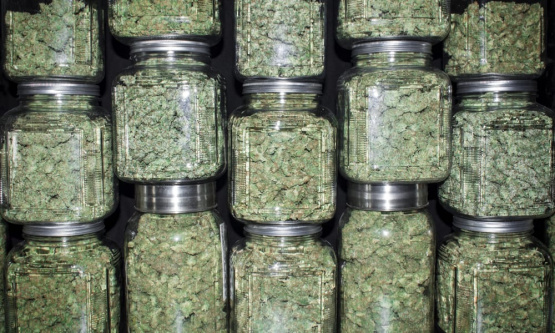What’s Going to Happen to Oregon’s Excess Pot?

A winter 2019 study by the Oregon Liquor Control Commission found that the state was producing twice the amount of cannabis as people were using. The excess in marijuana led to drops in prices, sinking prices from $10 to $5 per gram. Many blame the state’s approach to licensing.
Scott Phillips is to co-owner of the Boring Weed Company in Oregon. He said in an email that the state chose to lower its licensing barriers after witnessing the volatility in Washington State. “With no cap on licenses or limitations on out-of-state capital, overproduction was a predictable result,†he explained. “Anyone with qualifying land and a clean criminal history was eligible to become a licensed producer.†He singled out the southern region of the state for the glut due to its ideal environment for outdoor growing.
Phillips also said the numbers didn’t add up in Oregon. “In a state of 4 million people, where less than 20% of the population is a cannabis consumer, there is a limit to how much cannabis the state can consume itself.â€
Brad Bogus, VP of Growth & Marketing at Confident Cannabis, agrees with the numbers not adding up. He considers Oregon’s crops the tops in the nation. Once the state legalized, however, its status as an export state ceased to be. He explained, “So what used to be sent to other states and countries is now locked into the state’s borders, and the growers that used to be exporting are mostly licensed now, so there’s nowhere for all their cannabis to go.â€
While the belief is that Oregon’s oversupply predicament could occur in other states, including Missouri, the problem is largely unique. Nick Kovacevich, CEO of KushCo Holdings, Inc, said the situation is quite unique to Oregon because of its “relatively relaxed laws†on investing in the industry compared to states like California, Florida and Massachusetts. He said, “This means more investors can get in on the game there, leading to more supply.â€
Bogus saw Oregon’s history of production hindering it in the current market. “Most markets don’t have a legacy of growing over generations for the prohibited market like Oregon or California, so regulations aren’t disrupting an existing export market.â€
Respondents seem split on the future of the market. Phillips saw no solution currently available. He said the market needed to sort itself out. He did note that some producers have gotten desperate selling excess inventory to processors and wholesalers at razor thin margins. Kovacevich mentioned a similar outcome where excess is used for extracting compounds including THC and CBD but made no mention of margins.
Bogus saw two options, with one seeing a transition to a commodities market as the others mentioned. “Craft growers will find this objectionable, but there are buyers in Oregon looking for tens of thousands of pounds of lower grade material for processing and extraction.†He added, “Some growers may be able to survive the next few years until export by selling b-buds and trim to major processors and extractors, saving their craftwork for a small amount of their grow, or getting back to it when the borders fall.â€
The other option he suggested was one that caught attention on the national stage a few months back: exporting the excess. Bogus expanded on the work of one group advocating for the measure. “The One Fix Campaign being championed by the Craft Cannabis Alliance is having success forwarding the cause of Oregon partnering with other legal states on export agreements. This is required for Oregon’s market to bounce back.â€
While many believe that the measure would help the state, it is not feasible under current federal regulations. Phillips explained how the move, if passed, would benefit Oregon while other states spite their own markets. “Oregon could supply enough cannabis to the entire country if it were allowed to do so, but what incentive does a state like California have for pricing its own producers out of the market by allowing our cheaper imports? How will each state’s taxes be accounted for? Testing, tracking and transportation would need to be addressed.†He doesn’t expect the measure to pass until at least 2021.
The excess cannabis has undoubtedly led to producers seeing a decline in prices. Those savings, however, have not been passed onto the customer much, if at all. He explained that retailers would have to pass the savings on by lowering their prices as well. Phillips noted that there is little transparency to suggest that customers have seen this happen.
“Even if consumers are reaping a benefit, it’s artificial,†he said. “Federal cannabis laws force each state to become its own micro-market, only operating within its borders. In a truly national or international market, we would have a better understanding of the ebb and flow of supply and demand. Instead, Oregon is cannibalizing itself.â€
The possible decline in prices is not enough to justify the consequences currently unfolding, according to Bogus. “We’re losing amazing growers in the process. It’s great for consumers — sure, you get access to the world’s best weed for dirt cheap — but we all know that’s not right. We know people are going to lose money this way.†Phillips agreed that this outcome is likely to continue with the state legislature already voting down measures to cap licenses.
Bogus believes that federal legalization is likely coming in the next three to five years. As such, he sees this being a one-time event brought on by macro-economics factors and regulations. “Once those borders fall, and they will, this problem ceases to exist,†he notes. “The only hope is that we can see those borders go down sooner, rather than later, so we can keep as many of Oregon’s talented and experienced growers working in the industry.â€
The post What’s Going to Happen to Oregon’s Excess Pot? appeared first on High Times.